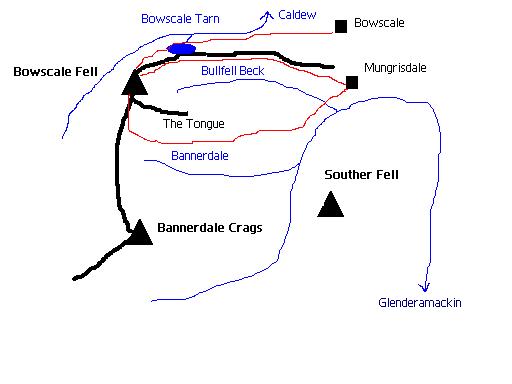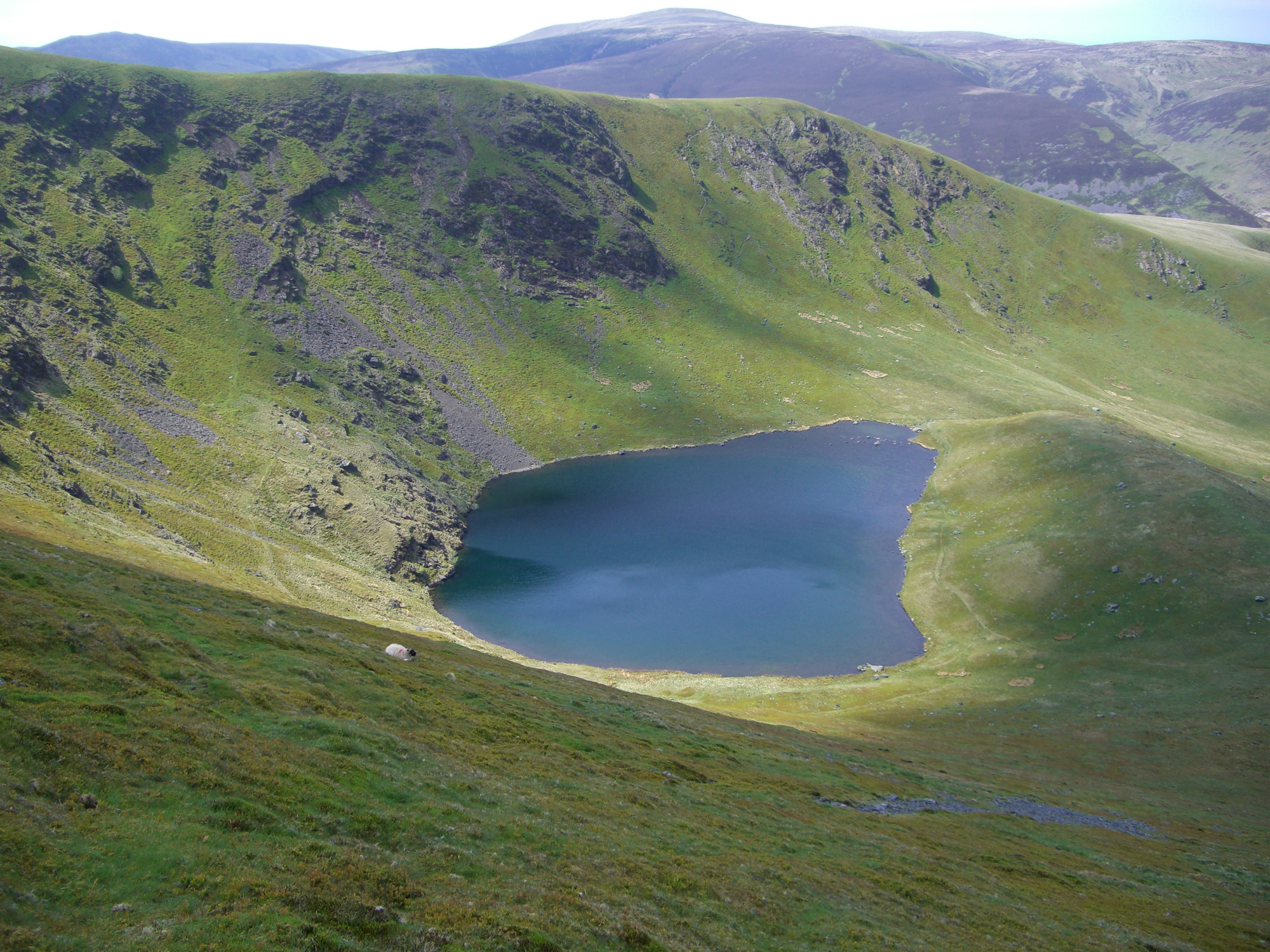Bowscale Fell on:
[Wikipedia]
[Google]
[Amazon]

 Bowscale Fell is a hill in the English Lake District. It rises above the village of Mungrisdale in the
Bowscale Fell is a hill in the English Lake District. It rises above the village of Mungrisdale in the
 Bowscale Fell is a hill in the English Lake District. It rises above the village of Mungrisdale in the
Bowscale Fell is a hill in the English Lake District. It rises above the village of Mungrisdale in the Northern Fells
The Northern Fells are a mountain range in the English Lake District. Including Skiddaw, they occupy a wide area to the north of Keswick. Smooth, sweeping slopes predominate, with a minimum of tarns or crags. Blencathra in the south-east of th ...
. Bowscale Fell stands at the extreme north east the Blencathra
Blencathra, also known as Saddleback, is one of the most northerly hills in the English Lake District. It has six separate fell tops, of which the highest is the Hallsfell Top at 2,848 feet (868 metres).
Name
For many years, Ordnance S ...
group, connected to this higher fell
A fell (from Old Norse ''fell'', ''fjall'', "mountain"Falk and Torp (2006:161).) is a high and barren landscape feature, such as a mountain or moor-covered hill. The term is most often employed in Fennoscandia, Iceland, the Isle of Man, pa ...
by the intervening Bannerdale Crags
Bannerdale Crags is a fell in the English Lake District. It stands between Blencathra and Bowscale Fell in the Northern Fells.
Topography
Bannerdale Crags is a ridge running north west to south east. The name was originally applied purely t ...
. In common with many fells the western slopes are smooth and convex while the eastern side exhibits crags.
Topography
A curving ridge surrounds the head of Bannerdale, with Bowscale Fell at the northern end and Bannerdale Crags to the south. The ridgeline is broad and grassy with occasional patches of bog and a couple of small tarns in the north. Bannerdale flows due east from the depression between the two fells to its junction with the River Glenderamackin. A second tributary of the Glenderamackin, Bullfell Beck, runs parallel a little to the north, its source being directly beneath the summit of Bowscale Fell. The heads of the two valleys are divided by a truncated east ridge, The Tongue, which sports a top (1,814 ft) at the far end. From below, The Tongue appears as an impressive pyramidal peak with steep slopes on all sides, obscuring the higher ground behind. A second, longer eastern ridge runs out to the north of Bowscale Fell, forming the northern wall of Bullfell Beck. This has two subsidiary tops at 2,017 ft and 1,981 ft and ends steeply at Raven Crag above the Mungrisdale to Heskett Newmarket road. Perched in a bowl scooped out on the northern face of this ridge is Bowscale Tarn. This is a classic corrie tarn, held in by a whalebackedmoraine
A moraine is any accumulation of unconsolidated debris ( regolith and rock), sometimes referred to as glacial till, that occurs in both currently and formerly glaciated regions, and that has been previously carried along by a glacier or ice sh ...
and having a depth of around 60 ft.Blair, Don: ''Exploring Lakeland Tarns'': Lakeland Manor Press (2003): Bowscale Tarn was a popular tourist attraction in Victorian
Victorian or Victorians may refer to:
19th century
* Victorian era, British history during Queen Victoria's 19th-century reign
** Victorian architecture
** Victorian house
** Victorian decorative arts
** Victorian fashion
** Victorian literature ...
times, visitors being brought by pony to observe its wild and moody setting. Wainwright, Alfred: ''A Pictorial Guide to the Lakeland Fells
''A Pictorial Guide to the Lakeland Fells'' is a series of seven books by A. Wainwright, detailing the fells (the local word for hills and mountains) of the Lake District in northwest England. Written over a period of 13 years from 1952, they ...
,Book 5 The Northern Fells'': Tastes change and the tarn now finds itself on few itineraries for a grand tour of the District. Legend had it that the tarn was home to two immortal fish, one version of the tale also crediting them with the gift of speech. Above the water is Tarn Crag, the steepest face on the fell.
The western and northern flanks of the fell drain to the River Caldew, which heads north east to Carlisle for a meeting with the River Eden, and thence to the Solway Firth
The Solway Firth ( gd, Tràchd Romhra) is a firth that forms part of the border between England and Scotland, between Cumbria (including the Solway Plain) and Dumfries and Galloway. It stretches from St Bees Head, just south of Whitehaven ...
. Northward across the deep cutting of the Caldew is Carrock Fell, while to the west are Great Calva
Great Calva is a fell in the Lake District, England. It is in the Northern Fells, lying roughly at the centre of this region of high ground. As a result, it is distant from roads and quite remote by Lakeland standards. Great Calva stands at ...
and Knott. Wainwright remarked that the western slopes of Bowscale Fell are drained by the Caldew which ultimately flows to the east, while the eastern slopes feed the Glenderamackin which soon turns west for Keswick and the River Derwent.
Being on the Derwent - Eden watershed, Bowscale Fell has further topographical significance by providing the link between the Northern and Eastern Fells. The eastern ridge continues almost imperceptibly beneath Raven Crag, crossing the road before rising again to form Little Eycott and Eycott Hills. From here the watershed runs south across Great Mell Fell and ultimately climbs onto Great Dodd
Great Dodd (meaning: ''big round hill'') is a mountain or fell in the English Lake District. It stands on the main ridge of the Helvellyn range, a line of mountains which runs in a north-south direction between the lakes of Thirlmere and Ul ...
in the Helvellyn range.
Summit
The summit of the fell bears a rash of stones although all else is grass. There is a windshelter at the highest point and a cairn a little to the north, marking the direction of Bowscale Tarn.Birkett, Bill: ''Complete Lakeland Fells'': Collins Willow (1994): The view of Blencathra and Sharp Edge is excellent, together with a surprising vista of theNorth Western Fells
The North Western Fells are a group of hills in the English Lake District. Including such favourites as Catbells and Grisedale Pike, they occupy an oval area beneath the Buttermere and Borrowdale valley systems. The North Western Fells are ch ...
through the Glenderaterra gap.
Ascents
A number of alternatives are available when starting from Mungrisdale. The easiest follows a gently rising track to the depression at the head of Bannerdale, while a variation is to turn off and climb steeply up the terminal slope of The Tongue. Bullfell Beck can also be followed to give the most direct ascent to the summit, but the best route is perhaps to follow the east ridge over its undulating tops. From Bowscale, a little along the road to the north, the Victorian pony route to Bowscale Tarn can still be followed, continuing up a grassy rake that bisects Tarn Crag. If a much longer walk is required, the ridge between Bowscale Fell and Bannerdale Crags can be reached from the Caldew Valley to the west. This makes Mosedale, or even Skiddaw House and points west into possible starting points.Ecology
Bowscale Fell is included in the Skiddaw Group Site of Special Scientific Interest. Unusual features include Young Wood which has been claimed to be the highest wood in England.Crumley, J (2021). ''Lakeland Wild''References